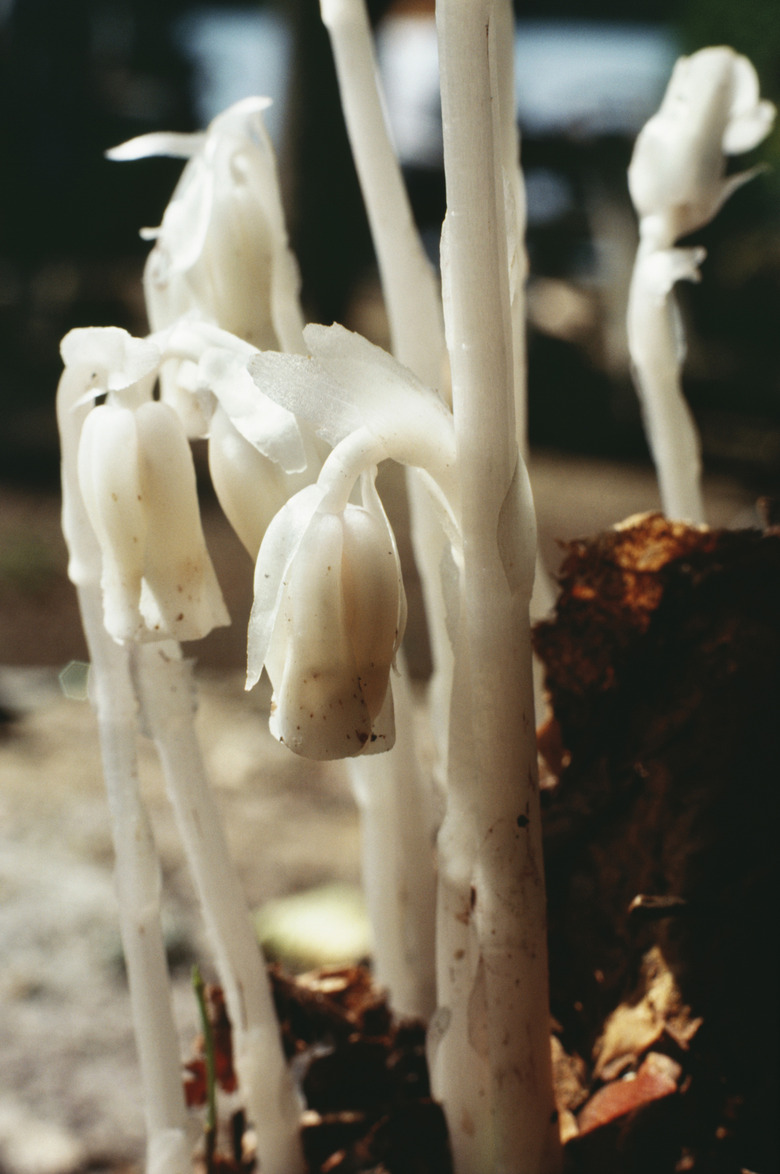What Do You Call Plants That Can't Make Their Own Food?
Saprophytic plants are part of a group of organisms called heterotrophs, which are plants and organisms that do not make their own food. Fungi also belong to this group. Saprophytic plants are uncommon and are rarely seen, but they play an important part in the ecosystems of the world.
Step 1
Most plants create their own food through a process called photosynthesis. These plants use chlorophyll to convert light, carbon dioxide and water into energy, which they use to grow. Plants that use chlorophyll are often called "green plants" because it is this chlorophyll that gives the plants their green hue. Plants that do not make their own food lack chlorophyll and are not green, but rather white, pink, yellow or even red.
Saprophytic Plants
Step 1
Unlike green plants, saprophytic plants lack the necessary ingredients to convert light, water and carbon dioxide into energy. Instead, they get their food from a different source. Two sources, in fact. The group can be loosely divided into two groups: Those plants that feed on a host plant, which are called parasitic plants, and those that feed on fungi, which are called mycotrophic plants.
Step 2
- Most plants create their own food through a process called photosynthesis.
- Unlike green plants, saprophytic plants lack the necessary ingredients to convert light, water and carbon dioxide into energy.
Parasitic Plants
Step 1
Parasitic plants attach themselves to the host plant with a special structure called a haustoria, which is found on the tips of the roots of the parasitic plant. The haustoria penetrates the tissue of the host plant, allowing the parasitic plant to draw nutrients from it. Conopholis americana, or squawroot, is an example of a parasitic plant. This plant is found in U.S. Department of Agriculture plant hardiness zone 5 and can often be found protruding from piles of leaves found on deciduous forest floors. In fact, squawroot is a favorite food of the brown bears that roam the Appalachian mountains.
Step 2
Mycotrophic Plants
Step 1
Mycotrophic plants also get their food from a host plant, but they do so indirectly. These plants attach themselves to a fungus that grows on the roots of the host plant. They withdraw the nutrients from the fungus. Mycotrophic plants are found in many plant families; quite a few orchids are mycotrophic, as are several plants in the Ericaceae family, including the ghostly white Indian Pipe (Monotropa uniflora), which is hardy in USDA zones 4 and 5.
Step 2
- Parasitic plants attach themselves to the host plant with a special structure called a haustoria, which is found on the tips of the roots of the parasitic plant.
Carnivorous Plants
Step 1
Carnivorous plants have chlorophyll and can make their own food, but that food isn't quite enough to grow on. Most carnivorous plants live in poor soils that lack nutrients. For this reason, these plants have developed mechanisms to catch and trap insects. Once trapped, the insects are slowly digested, and the nutrients are absorbed by the plant. The Venus fly trap (Dionaea muscipula) is a fairly well-known carnivorous plant. It grows in USDA zones 5 through 8 and is native to the southeastern part of the United States.
References
- UCLA Mildred E. Mathias Botanical Garden: Saprophytic Plants
- US Forest Service: Mycotrophic Wildflowers – What are they?
- Michigan State University Plant Encyclopedia: Monotropaceae – Indian Pipe Family
- Michigan State University Plant Encyclopedia: Orobanchaceae – Broomrape Family
- Missouri Botanical Garden: Dionaea Muscipula
